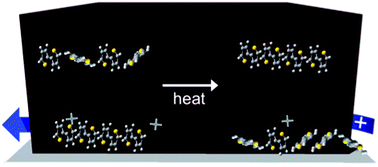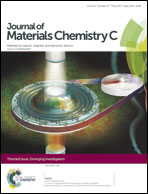Real-time structural evolution at the interface of an organic transistor during thermal annealing†
Abstract
Polarization multiplexed vibrational sum frequency generation (PM-VSFG) spectroscopy has been used to monitor the interfacial structure of polymer transistor interfaces in situ during thermal annealing treatments. The evolution of the field-effect carrier mobility is tracked simultaneously with the molecular orientation and ordering of poly(3-hexylthiophene) (P3HT) macromolecules on two different surface types. It is shown that fluorocarbon functionalized silica imparts very different molecular arrangements that avoid kinetic trapping during solution casting. In contrast, bare silica surfaces produce kinetically trapped polymer configurations that can be observed by PM-VSFG to reorient with thermal annealing. The interfacial results are compared to bulk structural changes in P3HT thin films as characterized by differential scanning calorimetry and linear spectroscopies. The electrical performances of these films are more closely correlated with interfacial parameters than the bulk properties of the polymer. In contrast with the bulk measurements, the PM-VSFG studies show that molecules at the organic/dielectric interface are actually less ordered after thermal annealing processes that render them with lower carrier mobilities.

- This article is part of the themed collection: Emerging Investigators

 Please wait while we load your content...
Please wait while we load your content...